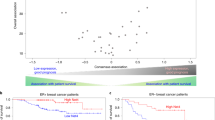Summary
Ultrastructural studies on the interactions of low and highly metastatic 3LL tumour lines with the basement membranes (BMs) of capillaries, veins, muscles, nerves and adipose tissue were performed by injecting tumour cells into the foot pad of mice. Haematogenous dissemination is the principle route of metastasis formation. Cells from the highly metastatic line were able to penetrate the blood vessels more efficiently than those from the low metastatic line. This difference was mainly due to a more pronounced diapedesis-like activity of the 3LL-HH cells, and partly to the altered intratumour vessel architecture in the highly metastatic tumour line. There was no difference between the two lines in the ultrastructure and frequency of invasion of nerves and adipose tissue BMs. However, in the highly metastatic line an extremely efficient penetration of muscle cell BM was observed. These results provide further evidence that the interaction of tumour cells with the BMs of different tissue types is one of the main determinants in local and distant dissemination.
Similar content being viewed by others
References
Auerbach R, Lu WC, Pardon E, Gumkowski F, Kaminska G, Kaminski M (1987) Specificity of adhesion between murine tumor cells and capillary endothelium: an in vitro correlate of preferential metastasis in vitro. Cancer Res 47:1492–1496
Babai F (1976) Etude ultrastructurale sur la pathogenie de l'invasion du muscle strié par des tumeurs transplantables. J Ultrastruct Res 56:287–303
Carr I, Carr J (1983) Lymphatic metastasis of neoplasms. In: Herberman RB, Friedman H (eds) The reticuloendothelial system. Plenum, New York, pp 35–57
Carr I, McGinty F, Norris P (1976) The fine structure of neoplastic invasion: invasion of liver, sceletal muscle and lymphatic vessels by the Rd/3 tumour. J Pathol 118:91–99
Constantinides P, Hewitt D, Harkey M (1989) Vessel invasion by tumor cells. An ultrastructural study. Virchows Arch [A] 415:335–346
De Bruyn PPH, Cho Y (1979) Entry of metastatic malignant cells into the circulation from a subcutaneously growing myelogenous tumor. J Natl Cancer Inst 62:1221–1227
De Bruyn PPH, Cho Y (1982) Vascular endothelial invasion via transcellular passage by malignant cells in the primary stage of metastasis formation. J Ultrastruct Res 81:189–201
Dingemans KP (1988) What's new in the ultrastructure of tumor invasion in vivo? Pathol Res Pract 183:792–808
Gabbert H, Gerharz CD, Ramp U, Bohl J (1987) The nature of host tissue destruction in tumor invasion. An experimental investigation on carcinoma and sarcoma xeno-transplantants. Virchows Arch [B] 52:513–527
Galasko CSB, Muckle DS (1974) Intrasarcolemmal proliferation of the VX2 carcinoma. Br J Cancer 29:59–65
Kitinya JN, Kinjo M, Tanaka K (1988) Growth and metastasis of Lewis lung carcinoma in the footpad of mice. Expl Cell Biol 56:221–228
Korach S, Poupon M-F, Du Villard J-A, Becker M (1986) Differential adhesiveness of rhabdomyosarcoma-derived cloned metastatic cell lines to vascular endothelial monolayers. Cancer Res 46:3624–3629
Lapis K, Timar J, Timar F, Pal K, Kopper L (1986) Differences in cell surface characteristics of poorly and highly metastatic Lewis lung carcinoma variants. In: Lapis K, Liotta LA, Rabson AS (eds) Biochemistry and molecular genetics of cancer metastasis. Martinus Nijhoff, Boston, pp 225–236
Liotta LA (1986) Tumor invasion and metastasis. Role of the extracellular matrix. Cancer Res 46:1–7
Liotta LA, Tryggvason K, Garbisa S, Hart I, Foltz CM, Shafie S (1980) Metastatic potential correlates with enzymatic degradation of basement membrane collagen. Nature 284:67–68
Martinez-Hernandez A, Amenta PS (1983) The basement membrane in pathology. Lab Invest 48:656–677
Nakamura M, Irimura T, DiFerrante D, DiFerrante N, Nicolson GL (1983) Heparan sulfate degradation: relation to tumor invasive and metastatic properties of mouse B16 melanoma sublines. Science 220:611–613
Nicolson GL (1982) Cancer metastasis: organ colonisation and the cell surface properties of malignant cells. Biochim Biophys Acta 695:113–176
Nicolson GL (1988) Cancer metastasis: tumor cell and host organ properties important in metastasis to specific secondary sites. Biochim Biophys Acta 948:175–224
Nicolson GL, Poste G (1983) Tumor implantation and invasion at metastatic sites. Int Rev Exp Pathol 25:77–179
Paku S, Paweletz N, Spiess E, Aulenbacher P, Werling H-O, Knierim M (1986) Ultrastructural analysis of experimentally induced invasion in the rat lung by tumor cells metastasizing lymphatically. Anticancer Res 6:957–966
Pal K, Kopper L, Lapis K (1983) Increased metastatic capacity of Lewis lung tumor cells by in vivo selectin procedure. Invasion Metastasis 3:174–182
Pal K, Kopper L, Timar J, Rajnai J, Lapis K (1985) Comparative study on Lewis lung tumor lines with “low” and “high” metastatic capacity. Invasion Metastasis 5:159–169
Sloane BF, Honn KV (1984) Cysteine proteinases and metastasis. Cancer Metast Rev 3:249–263
Song MJ, Reilly AA, Parsons DF, Hussain M (1986) Patterns of blood-vessel invasion by mammary tumor cells. Tissue Cell 18:817–825
Thorgeirsson UP, Turpeenniemi-Hujanen T, Liotta LA (1985) Cancer cells, components of basement membrane and proteolytic enzymes. Int Rev Exp Pathol 27:203–234
Timar J, Kopper L, Pal K, Lapis K (1983) Transmission and scanning-electronmicroscopy of experimental liver metastases derived from intrasplenically growing primary tumor. Pathol Res Pract 177:47–59
Tryggvason K, Höythya M, Salo T (1987) Proteolytic degradation of extracellular matrix in tumor invasion. Biochim Biophys Acta 907:191–217
Waller CA, Braun M, Schirrmacher V (1986) Quantitative analysis of cancer invasion in vitro: comparison of two new assays and tumor sublines with different metastatic capacity. Clinical Expl Metast 4:73–89
Warren BA (1981) Origin and fate of blood-borne tumor emboli. Cancer Biol Rev 2:95–169
Author information
Authors and Affiliations
Rights and permissions
About this article
Cite this article
Paku, S., Timár, J. & Lapis, K. Ultrastructure of invasion in different tissue types by lewis lung tumour variants. Vichows Archiv A Pathol Anat 417, 435–442 (1990). https://doi.org/10.1007/BF01606032
Received:
Accepted:
Issue Date:
DOI: https://doi.org/10.1007/BF01606032




